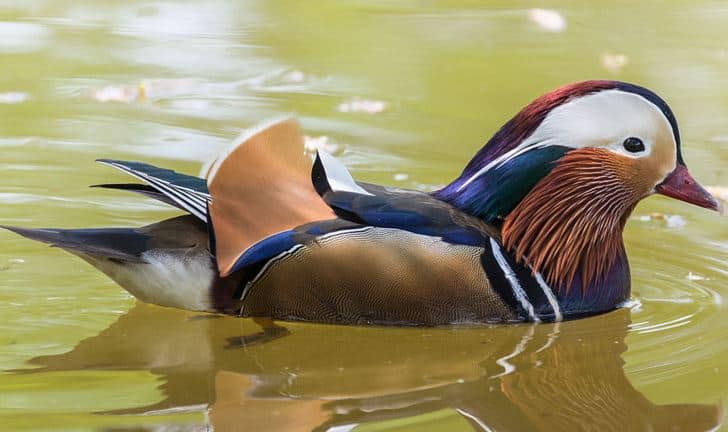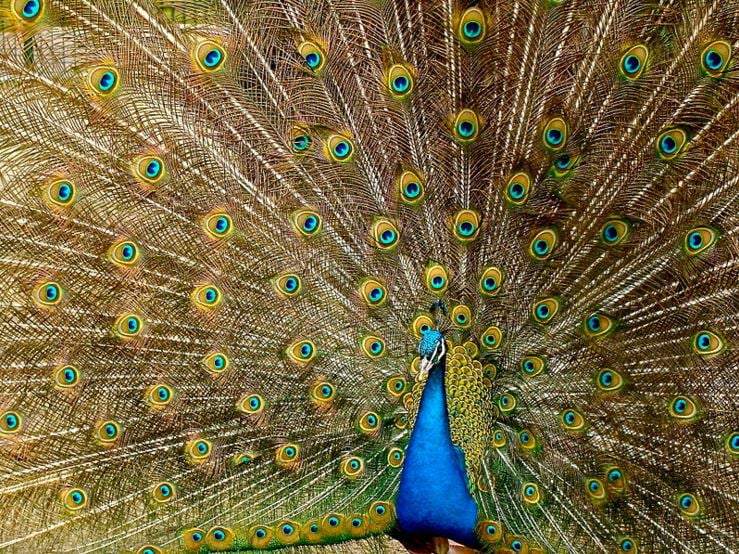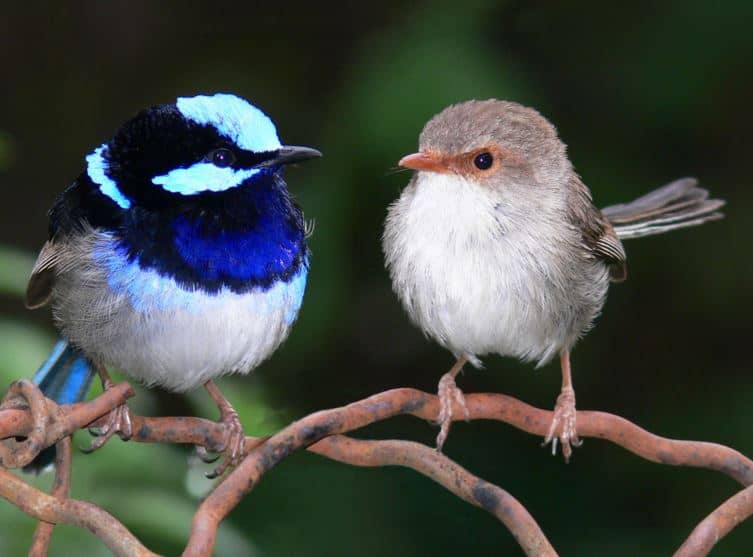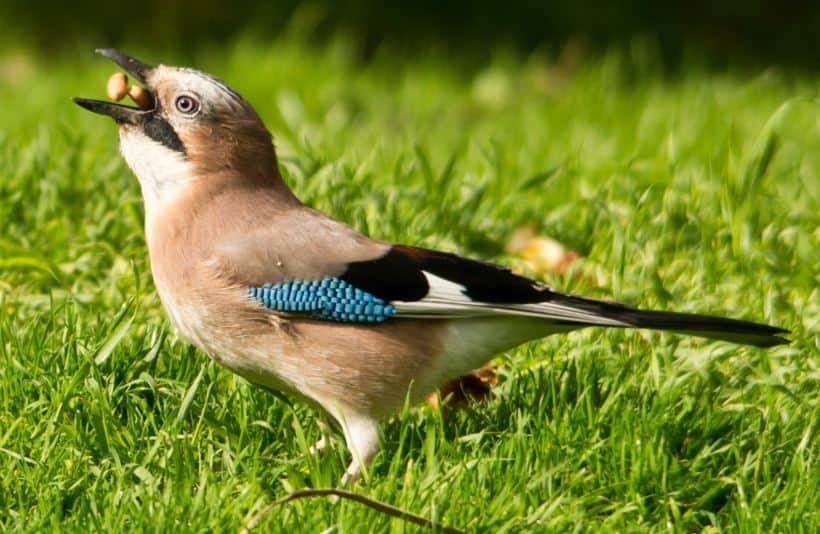Birds never go grey because of the structure of their feathers – this process could be used to make clothing and paint colours that never fade, says an international team of scientists. Bird feathers do not use dyes or pigments; they generate their own unique colour using a nanostructure with holes of different sizes in their feathers.
A nanostructure is a structure between miscroscopic and molecular in size, i.e. super-super-tiny.
Dr. Andrew Parnell of the University of Sheffield’s Department of Physics and Astronomy, and colleagues from the European Synchrotron Radiation Facility in France, the Institut Laue-Langevin in France, the Natural History Museum in London, and the Diamond Light Source (UK’s national synchrotron science facility), wrote about their latest study in the journal Nature Scientific Reports.
 The colourful mandarin duck (Aix galericulata). The drake’s (male’s) colours, as is the case with all birds, never fade. (Image: Wikipedia)
The colourful mandarin duck (Aix galericulata). The drake’s (male’s) colours, as is the case with all birds, never fade. (Image: Wikipedia)
The authors believe their discovery could lead to making synthetic structural colours that never fade; they could be used, for example, for colouring clothing and making paints. They claim it could be done cheaply.
The jay (Garrulus glandarius), for example, can alter the colour of its feathers along the equivalent of a single strand of human hair using tuneable nanostructure.
The scientists used X-ray scattering at ESRF (European Synchrotron Radiation Facility) in France to study the blue and white feathers of the jay.
Birds control colours of their feathers in an amazing way
The researchers discovered that birds demonstrate an incredible level of sophistication and control in producing colours.
They do not use dyes and pigments that eventually fade. Rather, they use finely-controlled changes to nanostructures to create a wide range of colours for their feathers – which the scientists believe they use, as jays appear to, to recognise one another.
The jay can pattern a wide range of colours along an individual feather barb (branch) – a bit like having many different colours along just a single strand of human hair.
 A Peafowl (Indian Peacock) flaring his feathers. For many bird species, maintaining a colourful plumage is vital for attracting mates. (Image: Wikipedia)
A Peafowl (Indian Peacock) flaring his feathers. For many bird species, maintaining a colourful plumage is vital for attracting mates. (Image: Wikipedia)
The jay’s feather, which ranges from white, blue, to ultra-violet, is made of a sponge-like keratin material that is exactly the same type of material our hair and fingernails are made from.
Nanoscopic holes determine feathers’ colours
According to the authors, jays can demonstrate amazing control over the size of the holes in the spongy structure, and adjust them to very specific sizes, which determine what colour is seen when light is reflected from the feather’s surface.
Light scatters after hitting a feather. How it scatters depends on the size of the hole, and thus the colour that is reflected.
To see the colour white you need larger holes, which have a broader wavelength reflectance. Conversely, for the colour blue, you need a more compact structure.
If birds used pigments and dyes to colour their feathers, they would eventually fade.
 Male and female Superb Fairy-Wrens (Malurus cyaneus). English naturalist and geologist Charles Darwin (1809-1882) believed that colour differences between sexes in birds result largely from female preference for bright colours in males. Most scientists support this view. However, perhaps female birds with dull colours are less likely to be spotted by predators when incubating their eggs. Colour may also help individuals in recognizing members of their own species. (Image: http://onarki.no)
Male and female Superb Fairy-Wrens (Malurus cyaneus). English naturalist and geologist Charles Darwin (1809-1882) believed that colour differences between sexes in birds result largely from female preference for bright colours in males. Most scientists support this view. However, perhaps female birds with dull colours are less likely to be spotted by predators when incubating their eggs. Colour may also help individuals in recognizing members of their own species. (Image: http://onarki.no)
Unlike hairy mammals, birds never go grey
Birds have been blessed with a permanent colouring system using structural changes. That it why birds, unlike mammals with hair, such as dogs, apes and humans, never grey as they get old.
Hairy mammals grey because the amount of pigment present in their hair declines with age.
Dr. Parnell said:
“Conventional thought was that to control light using materials in this way we would need ultra-precise and controlled structures with many different processing stages, but if nature can assemble this material ‘on the wing’, then we should be able to do it synthetically too.”
 A Eurasian Jay (Garrulus glandarius). In this study, its feathers were studied closely. Jays are famous for their acorn feeding habits. In the autumn you may see them burying acorns for retrieving later in the winter. (Image: RSPB)
A Eurasian Jay (Garrulus glandarius). In this study, its feathers were studied closely. Jays are famous for their acorn feeding habits. In the autumn you may see them burying acorns for retrieving later in the winter. (Image: RSPB)
“This discovery means that in the future, we could create long-lasting coloured coatings and materials synthetically. We have discovered it is the way in which it is formed and the control of this evolving nanostructure – by adjusting the size and density of the holes in the spongy like structure – that determines what colour is reflected.”
“Current technology cannot make colour with this level of control and precision – we still use dyes and pigments. Now we’ve learnt how nature accomplishes it, we can start to develop new materials such as clothes or paints using these nanostructuring approaches. It would potentially mean that if we created a red jumper using this method, it would retain its colour and never fade in the wash.”
Dr. Daragh McLoughlin, a member of the AkzoNobel Decorative Paints Material Science Research Team, said:
“At AkzoNobel, the makers of Dulux paint, we aim to encourage and stimulate the innovation of more sustainable products that have eco-premium benefits. This exciting new insight may help us to find new ways of making paints that stay brighter and fresher-looking for longer, while also having a lower carbon footprint.”
For this study, feathers from the Natural History Museum’s vast collection were used.
The findings of the study answered some long-standing questions regarding colours, Dr. Adam Washington, who works at the University of Sheffield, explained:
“The research also answers the longstanding conundrum of why non-iridescent structural greens are rare in nature. This is because to create the colour green, a very complex and narrow wavelength is needed, something that is hard to produce by manipulating this tuneable spongy structures.”
“As a result, nature’s way to get round this and create the colour green – an obvious camouflage colour – is to mix the structural blue like that of the jay with a yellow pigment that absorbs some of the blue colour.”
Reference: “Spatially modulated structural colour in bird feathers,” Andrew J. Parnell, David M. Whittaker, Andrew R. Parker, Adam L. Washington, Oleksandr O. Mykhaylyk, Andrew J. C. Dennison, J. Patrick. A. Fairclough, Christopher J. Hill, Mary Snape, Antonino Bianco, Richard A. L. Jones, Stephanie L. Burg, Ashley J. Cadby, Andrew Smith & Sylvain Prevost. Nature Scientific Reports 5, Article number: 18317. December, 21, 2015. DOI: doi:10.1038/srep18317.
Video – Colour: and the Birds-of-Paradise
The Birds-of-Paradise have virtually every colour of the rainbow on their feathers. While males have several vivid colours to attract a mate, females have a brownish plumage whose main purpose is camouflage. Ed Scholes, of the Cornell Lab, talks about these beautiful birds.

